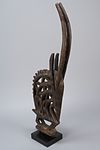chi-wara (Headdress)
About this object
History of use
A male Chi Wara (Ci Wara, Tyi Wara) headdress that is made to be danced as a pair with a female mask at harvest festivals to honour Chi Wara, a half human and half antelope mythical being who taught agriculture to the ancestors of the Bamana people. When humans became wasteful, Chi Wara buried himself in the earth and the Bamana created headdresses to represent him. Together, the male and female headdresses embody the ingredients necessary for successful cultivation. The dancers would hold sticks in their hands, to represent the movements Chi Wara made when he taught men how to cultivate, and the women would sing songs of praise for Chi Wara and the farmers. The headdress is attached to a wicker cap, which is strapped around the chin of a dancer.
Iconographic meaning
The headdresses are inspired by antelopes, armoured pangolins, and aardvarks. The antelope head represents the strength and grace needed to farm. The armoured pangolin's body represents protection, and the aardvark's legs represent good digging needed for farming. The male Chi Wara headdress represents the sun, while the female one represents the earth. The long horns represent the tall growth of millet. The fibre ties of the wicker cap, that the headdress would have been attached to, are associated with streams of water.
Specific techniques
The wood is oiled and then charred in fire to deepen the colour.
Physical description
Antelope headdress carved from wood. The figure has long curving horns incised with lines, an elongated and pointed stylized head incised with bands of linear pattern, the body is formed by concentric arches, the tail is short and pointed, and the legs are simplified and disproportionately small. The figure stands on a rectangular base.
Date Acquired
22 Oct 1990
How Acquired
Donated
Credit Line
Measurements
Overall: 76 cm x 6.5 cm x 25.5 cm
Object Number
Ag65
